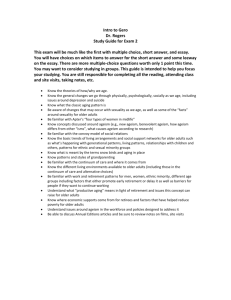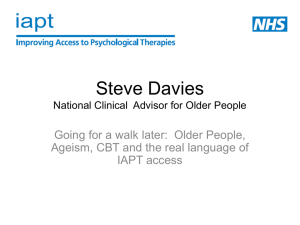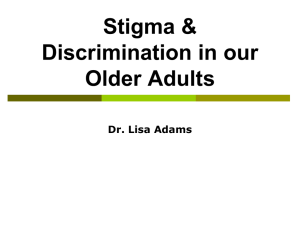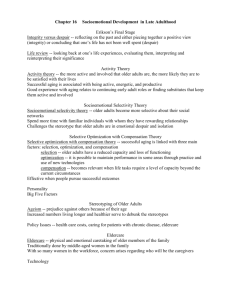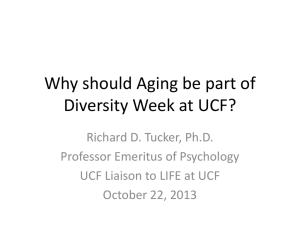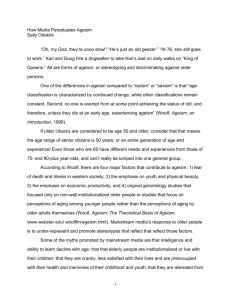Handbook on Ageism A preliminary outline
advertisement
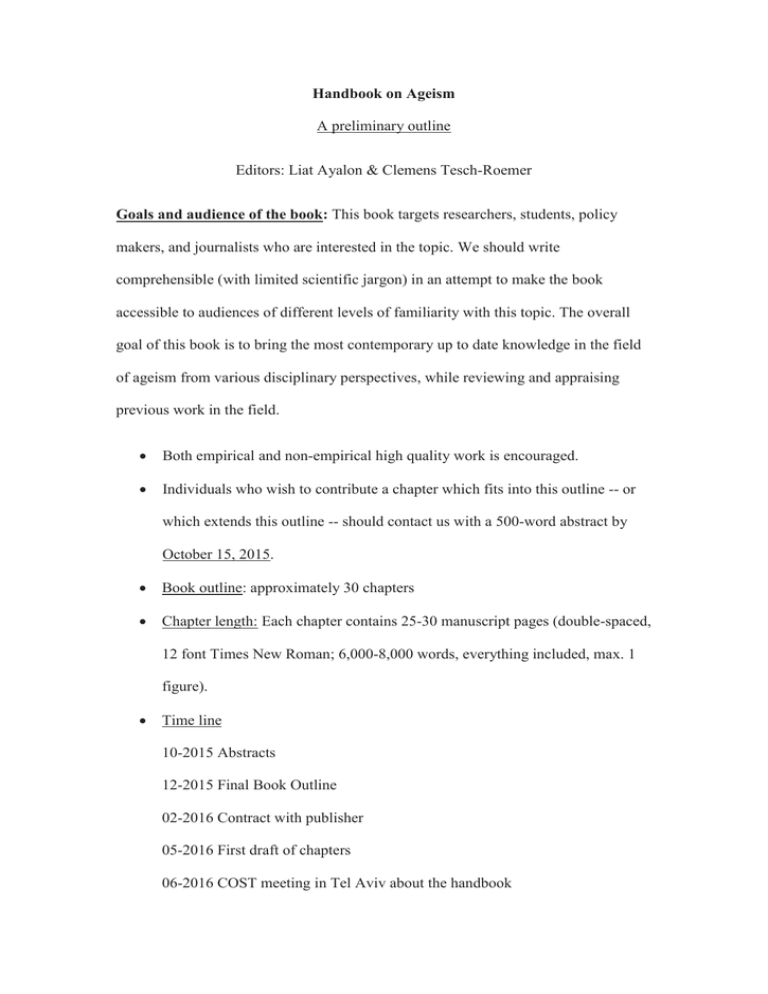
Handbook on Ageism A preliminary outline Editors: Liat Ayalon & Clemens Tesch-Roemer Goals and audience of the book: This book targets researchers, students, policy makers, and journalists who are interested in the topic. We should write comprehensible (with limited scientific jargon) in an attempt to make the book accessible to audiences of different levels of familiarity with this topic. The overall goal of this book is to bring the most contemporary up to date knowledge in the field of ageism from various disciplinary perspectives, while reviewing and appraising previous work in the field. Both empirical and non-empirical high quality work is encouraged. Individuals who wish to contribute a chapter which fits into this outline -- or which extends this outline -- should contact us with a 500-word abstract by October 15, 2015. Book outline: approximately 30 chapters Chapter length: Each chapter contains 25-30 manuscript pages (double-spaced, 12 font Times New Roman; 6,000-8,000 words, everything included, max. 1 figure). Time line 10-2015 Abstracts 12-2015 Final Book Outline 02-2016 Contract with publisher 05-2016 First draft of chapters 06-2016 COST meeting in Tel Aviv about the handbook 10-2016 A final version is sent to publisher 06-2017 Publication of the book (IAGG World Congress) Review Process Abstracts are reviewed by both editors. Each chapter is reviewed by one author of another chapter and at least by one of the editors. Selected chapters are discussed during the designated COST meeting. Publisher: TBD with the plan that Springer will be the publisher. Potentially seek open access as well as a printed version. Abstract requirements- 500 words max. When writing your abstract, please consider the following: How and where does your chapter fit in the outline of the handbook? Is the area you plan to cover broad enough (but not too broad) for a handbook chapter? Is there enough empirical research to cover this area? You might want to cite 5-10 major articles you plan to base your chapter on. Which sections and subheadings do you plan for your chapter? Which keywords will be covered in your chapter? Please include a 2-page CV with 5-10 of your most important references. Table of content 1. Ageism-defining the concept: The following chapters focus on the various definitions of ageism as well as philosophical perspectives concerning moral issues associated with ageism. 1.a. What is ageism? The term ageism was first coined by Robert Butler in 1969, but has since been defined and redefined over the years. Ageism is currently defined as the complex stereotypical perceptions of individuals because of their age. Ageism is directed towards both young and old individuals in society. This chapter explores the various definitions of ageism over time in an attempt to provide a comprehensive overview of the concept. 1. b. Is ageism always bad? There is ample evidence concerning the negative effects of ageism in all spheres of life. Similar to the other two "isms", ageism has a negative connotation. Nonetheless, categorization is a useful mechanism aimed to assist individuals to deal with the huge amounts of information in the world. Moreover, there are many situations in which ageism is seen as a form of preferential treatment, as in the case of giving one's seat to an older person. This chapter comprehensively addresses the positive and negative aspects associated with ageism. 2. The origins of ageism: The following chapters address different theoretical perspectives that attempt to explain the origins and maintenance of ageism. 2. a. The origins of ageism at the individual level. This chapter discusses theoretical arguments concerning the origins of ageism at the individual level. For instance, we know that human beings are afraid to die. In order to manage the "terror of death" cultures create cultural values which provide life (and death) with meaning (Terror Management Theory). Based on this idea, it can be assumed that ageism is one form of managing the anxiety to grow old and die. Another potential explanation for the origins of ageism lies in the social identity theory, which suggests that individuals try to identify with groups of high status in order to enhance their own self-perception. Because age is devalued in society, people attempt to distance themselves from all symbols associated with old age. 2.b. The origins of ageism at the societal context. Physical distance between individuals of different age groups in society reinforces cultural, linguistic, and affectional distance between the generations. Social distance at the societal level is perceived as a harbinger of ageism. This chapter addresses theories that attempt to explain the phenomenon of ageism at the social level. 3. On the manifestations of ageism: Ageism (i.e., the complex and often negative social construction of old age) is highly prevalent. Ageism occurs at the structural and the individual levels, and exists in many different contexts. The following chapters delineate the manifestations of ageism in various contexts in an attempt to provide a broad overview of the prevalence and consequences of ageism. 3.a.1 In the healthcare system-care availability and provision: Healthcare utilization and costs are disproportionately higher in this group and are expected to increase with the advancement of medicine and technology. This phenomenon has led some philosophers to wonder whether older Europeans have a duty to die, given the burden that the prolongation of life in old age puts on the healthcare and family systems. This chapter addresses the various age-inequalities present in the healthcare system and discusses some of the consequences associated with ageism. 3.a.2. In mismanagement of medication and other treatment strategies: This chapter will focus on medication mismanagement and inappropriate treatment associated with old age. The financial and social implications of such treatment will be explored. 3.b. In the workforce: One of the most important social arenas that reflects the depth and explicit negative expression of ageism is the labour force. Although, for the most part, older people are considered to be as productive workers as younger adults, older people are exposed to multiple sources of discrimination. This chapter explores these various sources of discriminations and their impact on older adults, the workforce and the economy. 3.c. In the judicial-legal system: The judicial decision making system suffers from ageism. For example, studies in the field of elder guardianship have found that courts tend to nominate guardians over older persons without seeing or hearing the elderly person, while adopting an ageist discourse which equates old age with mental incompetence. This chapter explores various aspects in which ageism is manifested in the judicial-legal system and ways this system has been responding to ageism. 3.d. In the media: The stereotypic portrayal of old age is evident in online and offline media. This chapter delineates some of the manifestations of ageism in the various forms of media and their consequences to older adults and society at large. 3.e. At the individual level: Internalized age stereotypes contribute considerably to ageism. Younger people internalize the predominantly negative societal views of older people (i.e. age stereotypes) which then also shape their self-perceptions of ageing as they grow older. This chapter provides an overview of the creation and manifestation of age-related stereotypes and their impact on individuals of different age groups. 3.f. In different cultures: Because ageism is a cultural phenomenon, it varies across cultures. This chapter explores diverse cultural norms and practices to better understand the cultural origins of ageism. 4. The consequences of ageism: There is ample evidence concerning the negative effects of ageism in all spheres of life. Ageism takes place at the structuralsocietal level, the family level and the individual level and is present in many different contexts. The following chapters address the consequences of ageism to the individual, to intergenerational relations and to society at large. 4.a. The consequences of ageism to the individual: The chapter addresses some of the negative consequences of ageism at the individual level. For instance, individuals who were exposed to internal or external ageism showed deteriorated physical and mental health and even a higher risk for mortality. 4.b. The consequences of ageism to intergenerational relations: One of the consequences as well as facilitators of ageism is reduced intergenerational contact. This chapter addresses the costs associated with ageism to the formation of relationships between the generations. 4.c. The consequences of ageism to society: Similar to the other two "isms," a society that allows high levels of inequality based on an arbitrary characteristic such as age is a society that reinforces artificial gaps between members of society. Such a society pays moral, financial and social costs associated with maintaining inequality. This chapter addresses the consequences of ageism at the societal level. 5. (How) should we respond to ageism? The following chapters discuss potential interventions that target ageism at the societal and individual levels. 5.a. Interventions that target ageism or age-related stereotypes at the individuallevel: This chapter explores interventions that target subjective age identity as well as intervention that improve one's attitudes and knowledge at the individual level. 5.b. Interventions that target ageism at the societal level: Potential effective interventions may include: a) raising public awareness and sensitizing civil society and b) enacting and enforcing laws and policies. This chapter discusses various interventions at the societal-level and explores their effectiveness and potential draw-backs. 6. Researching ageism: The following chapters concern issues related to the study of ageism. 6.a. How do we measure ageism? One of the challenges facing researchers interested in the study of ageism is its assessment. In past research, ageism was operationalized in many different ways, such as knowledge about ageing, attitudes towards older adults, or ageist behaviors. Ageism can be either self- or otherdirected. It also can be studied using qualitative means, such as drawings of older adults or focus group interviews. This chapter discusses various ways to assess ageism and various shortcomings and advantages associated with each method. 6.b. Recommendations for future research on ageism: Given our current knowledge, this chapter points to future research directions and their potential implications.
